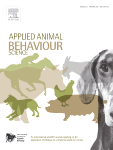Document type: scientific article published in Applied Animal Behaviour Science
Authors: Delphine Soulet, Anissa Jahoui, Rodrigo Guabiraba, Léa Lansade, Marie-Claire Blache, Benoît Piégu, Gaëlle Lefort, Vanaique Guillory, Pascale Quéré, Karine Germain, Frédéric Lévy, Scott A. Love, Aline Bertin, Cécile Arnould
Preview: Non-invasive markers of affective states can help understanding animals' perception of situations and improving their welfare. These markers are scarce in avian species. In this study, we investigate the potential relation between alterations in facial skin redness in hens and their corresponding affective states. Six hens were filmed in both naturally unfolding scenarios and controlled tests designed to elicit various affective states. The facial skin redness was measured from images extracted from the videos. Our observations revealed that hens exhibited the highest degree of facial skin redness in negative situations of high arousal, a high redness in positive situations of high arousal, and the lowest in positive situations of low arousal. In a second study, we further examined whether facial skin redness and secretory immunoglobulin A (S-IgA) can serve as markers for the quality of the human-animal relationship. Two groups of hens, one habituated to humans (n=13) and one non-habituated (n=12), were compared for general fearfulness in an open field test and for fear of humans in a reactivity to human test. In the open-field test, there were no statistical differences in general fearfulness, facial skin redness or S-IgA concentrations between both groups. However, habituated hens exhibited significantly lower fearfulness and facial skin redness in the presence of humans compared to non-habituated hens in the reactivity to human test. Additionally, habituated hens showed significant lower S-IgA concentration in lachrymal fluid in the presence of humans, with no significant differences in saliva or cloacal samples. We propose that changes in facial skin redness reflect variations in affective states and can be used as a marker for assessing the quality of the human-hen relationship. The relationship between S-IgA concentrations and affective states requires further investigation.






